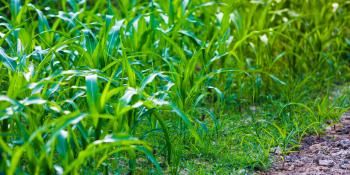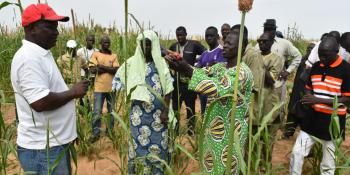Exploring targeting options for climate-smart agricultural investments in Kenya

CCAFS together with CIFOR and ILRI are developing an approach to support decision making processes that target proper climate-smart agricultural interventions in Kenya and ultimately Africa.
Agriculture is the main source of income for the Kenyan economy. According to the Kenya Economic Report (2013), the sector accounts for about 26 per cent of Kenya’s Gross Domestic Product (GDP) and 27 per cent indirectly through linkages with sectors such as manufacturing and distribution. The country’s population has been on a sharp increase, yet the agriculture sector has not been growing at the same rate. Almost 20 per cent of the population in the country receives food aid and is at constant risk of starvation.
Climate change has added to the many challenges facing the agriculture sector thereby hampering growth. In 2013, the Kenya National Climate Change Action Plan (NCCAP) put together by a number of stakeholders was launched in an effort to adapt to and mitigate climate change effects. Additionally, the plan would improve the country’s ability to take advantage of the opportunities that climate change offers.
Read more: Climate action in Kenya: New national plan launched
The NCCAP identifies priority adaptation actions per sector. For agriculture, these include targeting and implementing specific climate-smart adaptation actions that include promotion and bulking of drought tolerant traditional high value crops; water harvesting for crop production; index-based weather insurance; conservation agriculture; agro-forestry; and integrated soil fertility management.
However, the implementation of CSA practices on a national scale requires accurate prioritization of climate-smart investments that is evidence based to ensure maximum productivity from selected project areas. The CGIAR Research Program on Climate Change, Agriculture and Food Security East Africa (CCAFS EA) is collaborating with the Center for International Forestry Research (CIFOR) and the International Livestock Research Institute (ILRI) to develop and test a decision support framework that will facilitate the identification and prioritization of suitable CSA projects on a national scale.

CSA-targeting example using different data on precipitation and water issues to show the demand & potential for CSA-practices on drought tolerant cereal crops and the improvement of water harvesting & management
Methodology in the framework
Initially, a taskforce comprising stakeholders from government, private sector, universities and non-governmental organizations was formed to identify the critical parameters that build the basis for developing the decision support framework. These parameters include the integration of relevant quantitative information and stakeholder opinions, spatial targeting of relevant regions, and the consensus-oriented support of decisions.
A database containing quantitative and spatialized biophysical, livelihood and economic vulnerability variables and proxy data for CSA practices has been developed. This data was collected from publicly accessible sources and Kenyan governmental institutions.
Basically, the framework aggregates all the opinions of the different expert groups involved in the planning process and combines these with related spatial information from the database. Thereby ideal regions for CSA practices in question are proposed. One of the advantages of the framework is the increased level of consensus on where to target a project that implements specific CSA practices.
The framework takes into account biophysical, social and economic data to inform an assessment of where specific CSA practices are needed to reduce vulnerability by improving adaptation and mitigation capabilities. For instance, by applying spatialized vulnerability indicators, such as access to water, markets or gender equity in economic activities, we are able to identify counties whose agriculture is more susceptible to climate change, hence, showing a higher demand for certain CSA intervention practices.
Exploring and validating the results
To test this framework, a survey was conducted with 32 experts (of which 15 were female) drawn from cross-sectoral stakeholder groups to capture preferences on indicators of climate change vulnerability and CSA practices.

Stakeholder consultation is very important in prioritisation of csa interventions. Photo: s. Kilungu
Following the survey, consensually weighted indices of climate change vulnerability and CSA suitability were created based on a multi-criteria decision-making (MCDM) model. This allowed us to identify specific areas of high CSA potential in Kenya — regions with high climate change vulnerability and high suitability for included CSA practices.
The survey results were presented at a stakeholder workshop held in November 2014. During the workshop, a validation survey was conducted and mixed group discussions on ranking the indicators and CSA options were done. The aim was to investigate differences between consensus derived from the model and those from group interactions. It emerged that experts changed their opinions, to some degree, resulting in shifts of high CSA potential regions. One reason for that could be that stakeholders got new information in the meantime or were influenced by opinion leaders during the group discussions. Yet, some of these regions remained the same as in the original survey (potentially interesting for decisions on targeting CSA). In addition, an example was elaborated using the various information from the database and model results on stakeholder opinions. This CSA-targeting example focused on precipitation and lack of safe water sources as important vulnerability indicators as well as drought tolerant cereal crops, and water harvesting and management as prior CSA practices.
Way forward
In conclusion, created spatial indices could be used to inform decisions in CSA-targeting processes for Kenya. Changing expert opinions showed that experts needed to be more thoroughly integrated and surveyed iteratively. In 2015, the team working on the framework plan to apply it on a specific project identified with input from the government of Kenya. This will test the robustness of this approach and its effectiveness in identifying CSA practices and investments. The success of the project will see it implemented in other East African countries and then to the wider African region as a tool in CSA prioritization on national scales.
Access more information on CSA Prioritization:
Read more about Climate-Smart Agriculture Prioritization Framework
Patric Brandt is a PhD student working on the project: National and regional partnerships to support integration of climate change in agriculture and food systems. He is based at ILRI. Catherine Mungai is a Policy and Partnership Specialist working with CCAFS. Mariana Rufino is a senior scientist at CIFOR. She is also the lead scientist for the above project. Editted by Vivian Atakos, Communication Specialist- CCAFS East Africa



